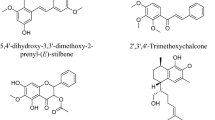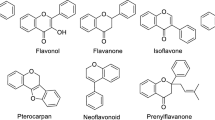Abstract
Propolis is a complex resinous product gathered by honeybees whose chemical composition is highly variable, depending strongly on the plant sources available to the bees at the site of collection. Propolis from several locations in Portugal, including islands, was fully characterized in terms of physicochemical properties, phenolic composition and antioxidant activity, enabling the establishment of quality standards. Color, frequently used as a commercial parameter, was accessed by the first time in propolis with the CIELAB system, and proposed as a quick and reliable method for quality recognition. The results attested the existence of two different types of propolis within the six regions under study. One, the poplar propolis most common in temperate regions, revealed a high content in phenolics and show high bioactivity. The other, with darker green color is less rich in phenolics and generally less bioactive.


Similar content being viewed by others
References
Burdock GA (1998) Review of the biological properties and toxicity of bee propolis (propolis). Food Chem Toxicol 36:347–363
Bankova VS, De Castro SL, Marcucci MC (2000) Propolis: recent advances in chemistry and plant origin. Apidologie 31:3–15
Bankova V (2005) Chemical diversity of Propolis and the problem of standardization. J Ethnopharmacol 100:114–117
Banskota AH, Tezuka Y, Kadota SH (2001) Recent progress in pharmacological research of propolis. Phytother Res 15:561–571
Tomas-Barberan FA, Garcia-Viguera C, Vit-Oliver P, Ferreres F, Tomas-Lorente F (1993) Phytochemical evidence for the botanical origin of tropical propolis from Venezuela. Phytochem 34:191–196
Silici S, Ünlü M, Vardar-Ünlü G (2007) Antibacterial activity and phytochemical evidence for the plant origin of Turkish propolis from different regions. World J Microbiol Biotechnol 23:1797–1803
Sforcin JM (2007) Propolis and the immune system: a review. J Ethnopharmacol 113:1–14
Salatino A, Teixeira ÉW, Negri G, Message D (2005) Origin and chemical variation of Brazilian propolis. eCAM 2:33–38
Moreira L, Dias L, Pereira JA, Estevinho L (2008) Antioxidant properties, total phenols and pollen analysis of propolis from Portugal. Food Chem Toxicol 46:3482–3485
Miguel MG, Nunes S, Dandlen SA, Cavaco AM, Antunes MD (2010) Phenols and antioxidant activity of hydro-alcoholic extracts of propolis from Algarve, South of Portugal. Food Chem Toxicol 48:3418–3423
Falcão S, Vilas-Boas M, Estevinho LM, Barros C, Domingues MRM, Cardoso SM (2010) Phenolic characterization of Northeast Portuguese Propolis: usual and unusual compounds. Anal Bioanal Chem 396:887–897
Valente MJ, Baltazar AF, Henrique R, Estevinho L, Carvalho M (2011) Biological activities of Portuguese propolis: protection against free radical-induced erythrocyte damage and inhibition of human renal cancer cell growth in vitro. Food Chem Toxicol 49:86–92
Moreira LL, Dias T, Dias LG, Rogão M, Da Silva JP, Estevinho LM (2011) Propolis influence on erythrocyte membrane disorder (hereditary spherocytosis): a first approach. Food Chem Toxicol 49:520–526
Bonvehí JS, Coll FV, Jordá RE (1994) The composition, active components and bacteriostatic activity of propolis in dietetics. J Am Oil Chem Soc 71:529–532
AOAC (1995) Official methods of analysis, 16th edn. AOCS Press, Arlington
Woiski RG, Salatino A (1998) Analysis of propolis: some parameters and procedures for chemical quality control. J Apic Res 37:99–105
Gardana C, Scaglianti M, Pietta P, Simonetti P (2007) Analysis of the polyphenolic fraction of propolis from different sources by liquid chromatography tandem mass spectrometry. J Pharm Biomed Anal 45:390–399
Singleton V, Rossi JA (1965) Colorimetry of total phenolics with phosphomolybdic–phosphotungstic acid reagents. Am J Enol Viticult 16:144–158
Cvec J, Medić-Šarić M, Jasprica I, Zubčić S, Vitali D, Mornar A, Vedrina-Dragojević I, Tomić S (2007) Optimization of an extraction procedure and chemical characterization of Croatian propolis tinctures. Phytochem Anal 18:451–459
Popova M, Bankova V, Butovska D, Petkov V, Nikolova-Damyanova B, Sabatini AG, Marcazzan GL, Bogdanov S (2004) Validated methods for the quantification of biologically active constituents of poplar-type propolis. Phytochem Anal 15:235–240
Brand-Williams W, Cuvelier ME, Berset C (1995) Use of free radical method to evaluate antioxidant activity. LWT 28:25–30
Oyaizu M (1986) Studies on product of browning reaction prepared from glucose amine. Jpn J Nutr 44:307–315
Popova MP, Bankova V, Bogdanov S, Tsvetkova I, Naydenski C, Marcazzan GL, Sabatini AG (2007) Chemical characteristics of poplar type propolis of different geographic origin. Apidologie 38:306–311
Cunha IBS, Sawaya ACHF, Caetano FM, Shimizu MT, Marcucci MC, Drezza FT, Povia GS, Carvalho PO (2004) Factors that influence the yield and composition of Brazilian propolis extracts. J Braz Chem Soc 15:964–970
Bogdanov S (2011) The bee products: the wonders of the bee hexagon. Chapter 4. http://www.bee-hexagon.net/en/theproducts.htm Accessed April 2012
Krell R (1996) Value-added products from beekeeping. FAO—Food and Agriculture Organization of the United Nations, Roma
CIE (1986) Colorimetrie, 2nd edn. Central Bureau of the Commission Internationale de L’Eclairage, Vienna
Carreño J, Martínez A, Almela L, Fernández-López JA (1995) Proposal of an index for the objective evaluation of the color of red table grapes. Food Res Int 28:373–377
Chang CC, Yang MH, Wen HM, Chern JC (2002) Estimation of total flavonoid content in propolis by two complementary colorimetric methods. J Food Drug Anal 10:178–182
Kumazawa S, Hamasaka T, Nakayawa T (2004) Antioxidant activity of propolis of various geographic origins. Food Chem 84:329–339
Bonvehí JS, Gutiérrez AL (2011) Antioxidant activity and total phenolics of propolis from the Basque Country (Northeastern Spain). J Am Oil Chem Soc 88:1387–1395
Magalhães LM, Segundo MA, Reis S, Lima JLFC (2008) Methodological aspects about in vitro evaluation of antioxidant properties. Anal Chim Acta 613:1–19
Acknowledgments
Soraia I. Falcão thanks FCT for the Ph.D. grant SFRH/BD/44855/2008, financially supported by POPH-QREN and FSE. Thanks also to FCT for the financial support provided to CIMO (PEst-OE/AGR/UI0690/2011). Thanks are also due to the National Federation of Portuguese Beekeepers for propolis samples.
Author information
Authors and Affiliations
Corresponding author
Electronic supplementary material
Below is the link to the electronic supplementary material.
About this article
Cite this article
Falcão, S.I., Freire, C. & Vilas-Boas, M. A Proposal for Physicochemical Standards and Antioxidant Activity of Portuguese Propolis. J Am Oil Chem Soc 90, 1729–1741 (2013). https://doi.org/10.1007/s11746-013-2324-y
Received:
Revised:
Accepted:
Published:
Issue Date:
DOI: https://doi.org/10.1007/s11746-013-2324-y




